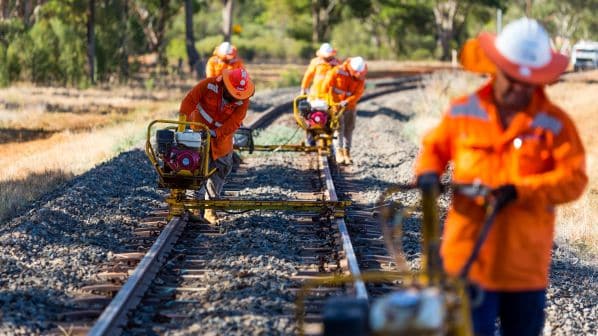HISTORIC heatwaves, torrential rain and widespread drought were reminders for us all throughout 2022 of the urgent need to address climate change. While passenger operators are still working out how to adjust to changes in travel patterns from people continuing to work at home following the Covid-19 pandemic, reducing carbon emissions remains the dominant trend that will drive rapid progress in the rail sector over the coming years.
As Systra CEO, Mr Pierre Verzat, reveals, there is a general appetite among governments to do “whatever it takes” to meet their respective targets, describing the number of offers the company has received in the last 12 months as “incredible.” And as we show throughout this issue of IRJ, our traditional look at the year ahead, there are railway projects across the world to get excited about.
Yet there is caution about the sector’s ability to deliver.
With a $A 154bn pipeline of work in the next 15 years, Australia is an investment hotspot. However, a recent Infrastructure Australia (IA) report warns that inflation and skills shortages will result in delays and cost overruns. It is “no longer a question of whether a project will slip, but more likely when, by how long and at what cost,” IA says.
The $US 2.3bn allocation by the US federal government to support projects to expand and establish new inter-city rail links in 2023 is an enticing development but there is caution about the readiness of projects and the capacity to deliver the upgrades required. Similar concerns are repeated around the world.
The increase in the cost of simple materials like wood, which has gone up by 60%, is also having a negative impact.
Covid restrictions on travel have largely ended. However, the pandemic hangover endures, heightened by the continuing war in Ukraine. High levels of inflation stoked by surging energy prices and supply chain issues, which have led to soaring raw material costs and a shortage of key components such as semiconductors, have all posed major challenges for the railway industry in 2022 and will continue to be dominant themes in 2023.
The major manufacturers appear to have the scale to ride out the storm. However, there is now immense pressure on small and medium enterprises, the “backbone” of the industry.
Mr Roger Dirksmeier, managing director for rail systems at Fogtec, a supplier of fire detection and suppression systems for rolling stock, who represents the SME committee on the presiding board of the European Rail Industry Association (Unife), says that many companies may not survive in the current climate. He lists several major challenges that Fogtec and other SMEs are facing.
First, while he says order books are generally strong, projects have slowed down, meaning it takes longer to get paid, putting pressure on companies that are not financially resilient, in particular those dependent on a single customer. Getting clients to pay invoices can also be difficult.
Contracts are also more complex to close. The inability to meet face to face made things difficult throughout the pandemic while demands on suppliers from the OEMs have seemingly intensified. Dirksmeier cites the case of one supplier asking for 55 documents to be submitted in the bidding phase for one project, taking up precious time and resources without a guarantee that the sub-supplier will win the work.
Sourcing components and materials is extremely problematic, slowing down delivery. Dirksmeier says brokers have taken advantage of the pandemic situation by hoarding large quantities of components, which they are now selling at highly inflated prices. He cites the cost of a chip processor which has increased from 84 cents pre-pandemic to $US 130 now. “We need 1500 of them each quarter,” he says. “You can imagine what it does to a company like ours.”
The increase in the cost of simple materials like wood, which has gone up by 60%, is also having a negative impact. “I have colleagues on the SME committee who are unable to supply their products because they do not have wood for packaging,” he says.
Dirksmeier says Fogtec has responded to these challenges by expanding warehouse capacity to maintain a sufficient volume of components for delivery. He also says the company has increased its energy budget by 300% in 2023 while it has offered extra payments to staff to help them tackle the increase in the cost of living.
However, Dirksmeier feels that it should not be left to SMEs to swallow these cost increases entirely. He advocates the adoption of escalation clauses by operators and fleet owners with realistic timeframes for delivery. He argues that this will provide more certainty for both OEMs and SMEs.
While Dirksmeier expects the material cost challenge to dominate the first half of the year, difficulties in recruiting and retaining staff are likely to be a long-term trend.
Many people see work very differently from three years ago. Theoretically being able to work from anywhere opens up more opportunities from a wider pool of potential employers. On the flip side, this is making it increasingly difficult for smaller companies to compete for the best people. The desire to work from home also reduces chances for innovation during a chance conversation by the coffee machine, according to Dirksmeier.
Fogtec has approached this challenge by limiting home working to two days a week. It has also invested in its offices by adding more meeting areas and a barbecue terrace, organised social events for employees and their families, and is offering additional perks for employees such as subsidised gym memberships. “Our approach is to be the Fogtec family,” Dirksmeier says. “It is the only weapon we have.”
Being proactive is essential in the current climate. As is a little give and take from all sides. The current challenges will subside. And when they do, it is important that the industry remains as strong as possible to tackle society’s major challenge: the climate emergency. Welcome to The Railway in 2023.

